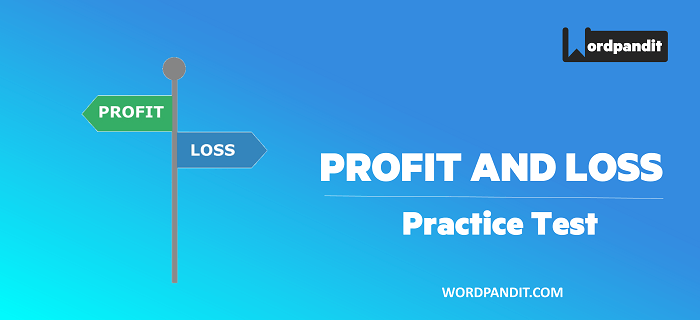- This is an assessment test.
- To draw maximum benefit, study the concepts for the topic concerned.
- Kindly take the tests in this series with a pre-defined schedule.
Arithmetic: Profit and Loss Test -6
Congratulations - you have completed Arithmetic: Profit and Loss Test -6.You scored %%SCORE%% out of %%TOTAL%%.You correct answer percentage: %%PERCENTAGE%% .Your performance has been rated as %%RATING%%
Your answers are highlighted below.
Question 1 |
A man invested Rs. 8000 for a year in the share market. At the end of the year, he gained 15% and he invested the amount with profit again for the second year. At the end of the second year, he suffered a loss of 15%. Find the gain or loss per cent in the investment after two years.
Gain 3.25% | |
Loss 2.25% | |
No loss no gain | |
Loss 5% |
Question 1 Explanation:
If we see the question we can say that
Amount after one year with 15% gain = 8000 x 115/100= Rs 9200
Again with a loss of 15% then
Amount after 2nd yr = 9200 x 85/100 = 7820
Therefore
Loss per cent
= (8000 -7820)/8000 x 100 = 2.25%
Amount after one year with 15% gain = 8000 x 115/100= Rs 9200
Again with a loss of 15% then
Amount after 2nd yr = 9200 x 85/100 = 7820
Therefore
Loss per cent
= (8000 -7820)/8000 x 100 = 2.25%
Question 2 |
By selling an article at 80% of its marked price, Meera makes a loss of 12%. What will be the percent profit or loss made by the Meera if she sells the article at 95% of its marked price?
5.5% profit | |
1% loss | |
5% profit | |
4.5% profit |
Question 2 Explanation:
Let the cost price =Rs p.
Since the article is sold at 80% of its marked price so
Selling price = 0.88 p
therefore Marked price of article
= 0.88/80 x100 x p=1.1p
= New selling price of article = 1.045p
= {(1.045x – p)/p} x 100= 4.5%
Since the article is sold at 80% of its marked price so
Selling price = 0.88 p
therefore Marked price of article
= 0.88/80 x100 x p=1.1p
= New selling price of article = 1.045p
= {(1.045x – p)/p} x 100= 4.5%
Question 3 |
What is the maximum percentage discount that a merchant can offer on her marked price so that she ends up selling at no profit or loss, if she had initially marked her goods up by 50%?
16.67% | |
33.33% | |
50% | |
20% |
Question 3 Explanation:
Let cost price = Rs 100
Marked price = Rs 150 (50% initially she had)
So maximum discount percentage is = 50/150 x 100 = 33.33%
Marked price = Rs 150 (50% initially she had)
So maximum discount percentage is = 50/150 x 100 = 33.33%
Question 4 |
A tradesman gives 4% discount on the marked price and 1 article free with every 15 articles still gains 35%. The marked price is more than cost price by?
40% | |
39% | |
20% | |
50% |
Question 4 Explanation:
Let the C.P of each article be Rs p
Then C.P of 16 articles=Rs (px16) =Rs 16p
S.P of 15 articles =16p x (135/100)=Rs 21.6
S.P of each article =21.6/15=Rs 1.44
When S.P is Rs 0.96(after 4%discount), marked price =Rs p
And S.P is Rs 1.44, marked price = (p/0.96p)x1.44=Rs 1.5p
Therefore marked price=50%
Then C.P of 16 articles=Rs (px16) =Rs 16p
S.P of 15 articles =16p x (135/100)=Rs 21.6
S.P of each article =21.6/15=Rs 1.44
When S.P is Rs 0.96(after 4%discount), marked price =Rs p
And S.P is Rs 1.44, marked price = (p/0.96p)x1.44=Rs 1.5p
Therefore marked price=50%
Question 5 |
Even after reducing the marked price of pen by Rs. 32, a shopkeeper makes a profit of 15%. If the cost price be Rs320, what percentage of profit does he make if he sells the pen at the marked price?
25% | |
20% | |
10% | |
30% |
Question 5 Explanation:
Profit percentage ={ (Selling price – Cost price)/(cost price)} x 100
Profit = 1.15
Therefore selling price
= 1.15 x 320 = Rs 368
But SP = MP - 32
So, MP = SP + 32 = 368 + 32 = Rs 400
so profit percentage=[{ 400 – 320}/320]x 100 = 25%
Profit = 1.15
Therefore selling price
= 1.15 x 320 = Rs 368
But SP = MP - 32
So, MP = SP + 32 = 368 + 32 = Rs 400
so profit percentage=[{ 400 – 320}/320]x 100 = 25%
Once you are finished, click the button below. Any items you have not completed will be marked incorrect.
There are 5 questions to complete.
List |
Table of Contents: Profit and Loss Complete Lesson
Concept Articles
Practice Tests











